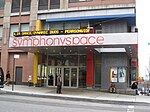Advent Lutheran Church (New York City)
19th-century Lutheran churches in the United StatesChurches completed in 1900Churches in ManhattanGothic Revival church buildings in New York CityLutheran churches in New York City ... and 2 more
Upper West SideWilliam Appleton Potter church buildings

Advent Lutheran Church is a church affiliated with the Evangelical Lutheran Church in America located in the Upper West Side, Manhattan, New York City. The church building was designed by the architectural firm of William Appleton Potter (1842–1909).
Excerpt from the Wikipedia article Advent Lutheran Church (New York City) (License: CC BY-SA 3.0, Authors, Images).Advent Lutheran Church (New York City)
Broadway, New York Manhattan
Geographical coordinates (GPS) Address Phone number Website External links Nearby Places Show on map
Geographical coordinates (GPS)
| Latitude | Longitude |
|---|---|
| N 40.792713888889 ° | E -73.972733333333 ° |
Address
Advent Lutheran Church
Broadway 2504
10025 New York, Manhattan
New York, United States
Open on Google Maps








